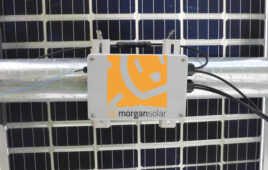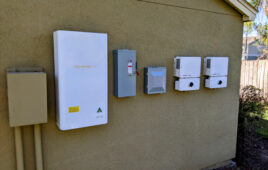By Dean Schoeder and Diane McClelland of Trimark Associates
In utility-scale PV power generation, many elements must be synchronized to ensure high system performance. Resource owners use monitoring instruments, information systems and operational control systems as tools to meet compliance requirements, operate effectively and manage long-term plant performance.
Technology plays a role in three areas of plant performance: Regulatory compliance, operations and asset management.
 Technology and regulatory compliance
Technology and regulatory compliance
ISOs, balancing authorities and host utilities establish requirements for resource owners like solar solar to connect to the electric grid and participate in open energy markets. Requirements addressing business, electrical, environmental, security and data exchange are defined in the interconnection agreement and PPA, with more requirements mandated by the ISO/balancing authority. It is the developer’s responsibility to deploy systems that comply with these requirements.
Compliance-related requirements fall into four areas:
1) Certified revenue metering
Revenue meters track energy delivered to the grid. Settlement-quality meter data (SQMD) documents power transactions. Without SQMD, a resource will not be paid for the power it produces. To be equitably compensated, resource owners need to:
- Meet the accuracy rating specifications from the host utility or balancing authority.
- Provide reliable communications via telephone lines, cellular modems, radio systems or secure T1 circuits.
- Comply with prescriptive meter certification processes.
2) Meteorological (MET) data
MET data is required to measure plant performance and forecast power generation. Real-time weather data is a key variable used to predict the resource’s ability to produce energy.
PV resources require MET data to:
- Meet PPA and ISO requirements.
- Establish a baseline to calculate performance.
- Forecast power production.
3) Grid management
Generation resources must deliver stable, reliable power at the point of interconnection (POI) with the electric grid. To support grid stability, utilities require the ability to curtail generation and to control voltage and frequency. Advanced PV plant control systems ensure that this occurs automatically while maximizing the allowable real power output.
Automated curtailment order response
Contracts may require a resource to respond to curtailment sent by a utility. Unmanned PV sites must have automated systems to validate and execute curtailment orders. Automation is the only practical way to comply with these requirements.
Managing voltage and frequency characteristics
Control systems support grid stability through automated logic designed to adjust and maintain stable voltage, frequency and power factor at the POI. They also protect the resource’s interests by creating a historical record of exactly what occurred at the connection.
A SCADA system should automatically maintain the target voltage at the POI despite changing irradiance or system losses. Control systems must coordinate command of all site inverters and capacitor banks to make synchronized, real-time adjustments.
4) Secure data telemetry for site security and generation capacity
Data telemetry is used by balancing authorities and utilities to manage PV sites in real-time. These authorities need to protect the integrity of commands issued to generation resources. Telemetry must also be secure to support confidential operational data.
Technology and operations
The primary business objective of a utility-scale PV SCADA system is to maximize power generation. In addition to accurate settlements of energy transactions and secure data telemetry (as previously mentioned), situational awareness and forecasting and performance modeling also serve as the business drivers that enable peak performance and maximize revenue.
Situational awareness
Accuracy and timeliness in measuring asset performance is essential to generate maximum power potential. PV site managers need:
- Precise, real time and historical documentation of performance, meteorological conditions, grid requirements and market demands.
- Accurate data to plan for maintenance and repairs.
- Alerts and alarms when an unexpected event occurs or key measures exceed a threshold.
- Automated, consistent reports for compliance, incentive programs or analysis (e.g. lost power).
These are generated by a SCADA system.
Forecasting and performance modeling
Projecting site performance helps determine maintenance cycles and identify performance issues. Forecasts also support financial decisions.
Technology and asset management
Information—generated by SCADA systems, work order management systems, inventory systems and financial systems—is the foundation of effective asset management. Asset management benefits from tight integration with SCADA.
By sharing data between systems, managers can deploy strategies, including performance management, failure mode analysis, warranty management, capital planning and scheduling.
Operational data helps to identify conditions and trends that are difficult to see in the short term. SCADA systems can identify leading indicators of wear, failure modes, or indexes that compare data gathered from multiple devices.
Technology has an overarching and long-term effect on resource performance and revenue. It is essential to determine how a technology platform will support and integrate all aspects of a resource. Sourcing the technology from an experienced and proven supplier will ensure that a PV site will realize its maximum power generation and profitability levels.
Trimark Associates offers solutions for informed energy management, real-time operational control and complete regulatory compliance.






Tell Us What You Think!